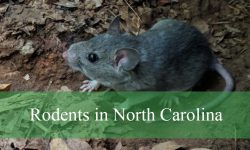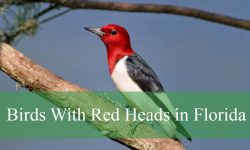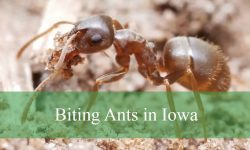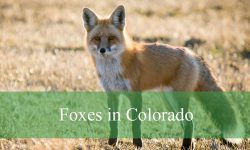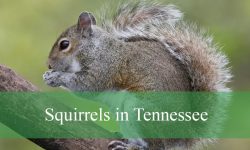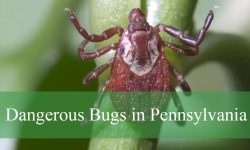Kansas hosts an impressive diversity of frogs that thrive in its ponds, marshes, and grasslands. Each species contributes to the state’s natural balance by controlling insects and serving as an important food source for birds, fish, and reptiles. Their presence signals clean water and healthy ecosystems across the region.
The combination of open prairies, shaded woodlands, and calm wetlands allows a wide range of frogs to flourish. Spring nights echo with the calls of Chorus Frogs, while summer brings the deep booming of Bullfrogs along ponds and lakes. Even small temporary pools can become busy breeding grounds after heavy rains.
This guide introduces 15 types of frogs in Kansas, featuring their key traits, habitats, and fascinating behaviors. Each section includes detailed identification notes and insights that highlight the diversity and adaptability of these remarkable amphibians.
Different Types of Frogs Found in Kansas
American Bullfrog (Lithobates catesbeianus)
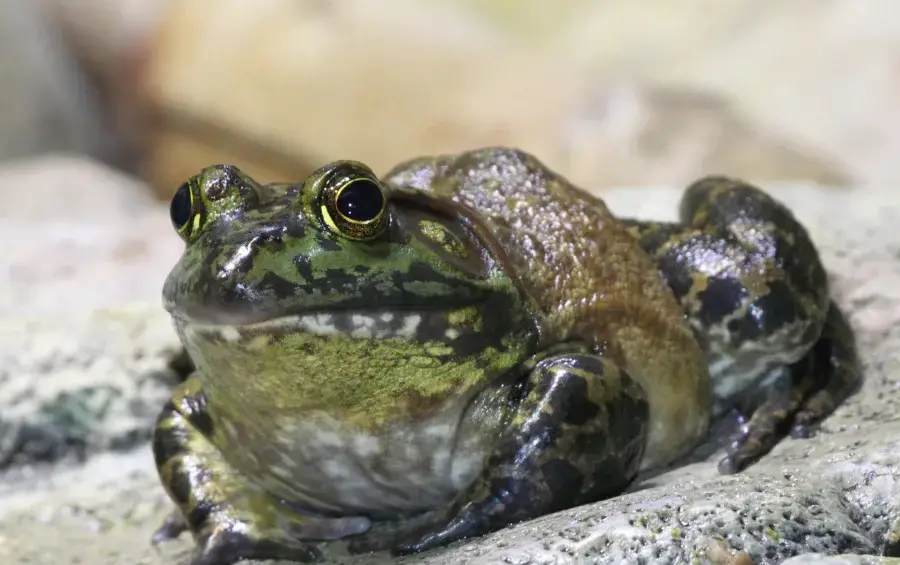
The American Bullfrog is the largest frog species in Kansas and across much of North America. Adults can grow up to 8 inches long, with a green to olive-brown body often marked by dark mottling. Their large, round tympanum (eardrum) and powerful legs are distinctive features, perfectly adapted for jumping and swimming. Bullfrogs are easily recognized by their deep, resonant call that sounds like a distant cow’s moo.
These frogs prefer still or slow-moving freshwater habitats such as ponds, lakes, and marshes. They thrive in environments with abundant aquatic vegetation, which provides both shelter and hunting grounds. Bullfrogs are primarily nocturnal and spend most of their time near water, rarely venturing far from it.
As voracious predators, American Bullfrogs eat a wide variety of prey including insects, small fish, crustaceans, and even other frogs. Their strong jaws and quick reflexes make them efficient hunters capable of capturing surprisingly large meals. This predatory behavior, however, can threaten native amphibian populations in some areas.
In Kansas, bullfrogs are most active from late spring through early fall. They hibernate during the cold months buried in mud or underwater debris. Adapted to a wide range of climates, they are found throughout the state and can tolerate a variety of water conditions, making them a dominant amphibian species in Kansas wetlands.
Northern Leopard Frog (Lithobates pipiens)
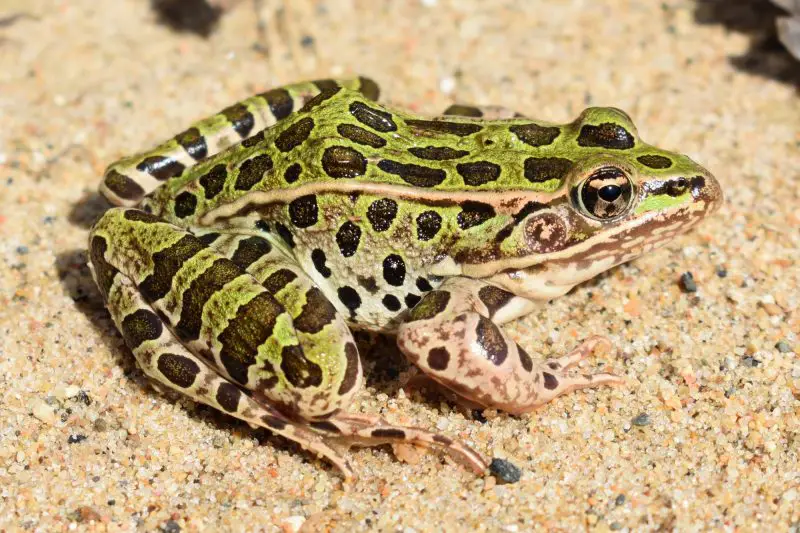
The Northern Leopard Frog is one of the most recognizable frogs in Kansas, easily identified by its green or brown skin covered with dark oval spots bordered by light halos. Adults typically measure 2 to 4 inches long and have a slender body with long legs built for leaping. When disturbed, they make quick, powerful jumps and dive into nearby water for safety.
These frogs inhabit meadows, grasslands, marshes, and streams, often preferring open areas close to permanent water. They require clean, unpolluted water for breeding and laying eggs, which makes them sensitive indicators of environmental health. During the breeding season in spring, males produce a soft, snoring-like call to attract females.
Northern Leopard Frogs are opportunistic feeders, consuming insects, worms, spiders, and even small birds or snakes when available. Their diet varies with habitat, and they often forage along the edges of ponds or in grassy fields after rain. Their long, sticky tongues allow them to capture prey efficiently.
In Kansas, they are found mostly in the northeastern and central regions, where moisture levels are sufficient to support their needs. While once abundant, their populations have declined in some areas due to habitat loss, pollution, and disease. Conservation of wetlands plays a key role in maintaining healthy populations of this striking frog.
Plains Leopard Frog (Lithobates blairi)
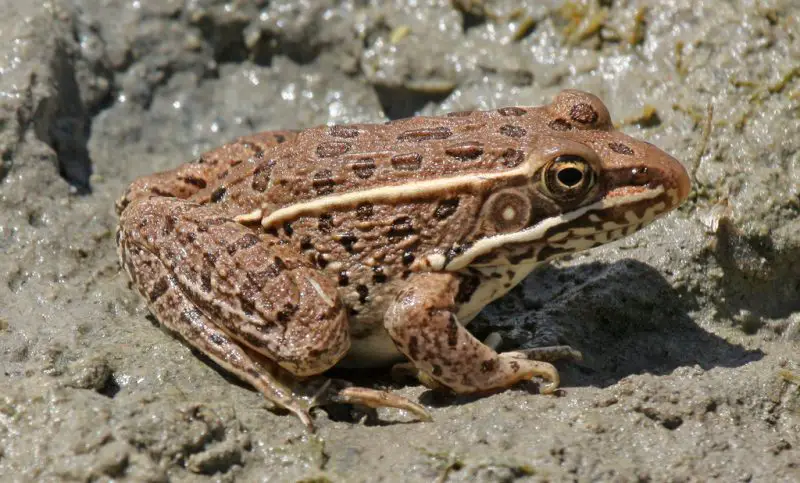
The Plains Leopard Frog closely resembles the Northern Leopard Frog but is generally more tan or light brown with distinct light lines along its back and irregular dark spots. Adults grow up to 3.5 inches long and have a pale, raised ridge running from behind the eye to the hip, ending abruptly near the groin—a key identification feature.
Native to the central United States, this species thrives in the grasslands, prairies, and wetlands of Kansas. They prefer temporary ponds and slow-moving streams, often using flooded ditches and pastures as breeding sites. Their adaptability to both natural and man-made water sources makes them widespread throughout the state.
The call of the Plains Leopard Frog is a series of chuckling grunts or clucks, most commonly heard during the warm spring nights when breeding begins. Females lay large clusters of eggs that hatch into tadpoles, which grow rapidly in the warm Kansas waters. These frogs are mostly nocturnal and are especially active after rainfall.
In Kansas, they are common in the central and western regions, where they play an important role in the local ecosystem by controlling insect populations. Their ability to survive in semi-arid conditions sets them apart from many other frog species that require more humid environments.
Southern Leopard Frog (Lithobates sphenocephalus)
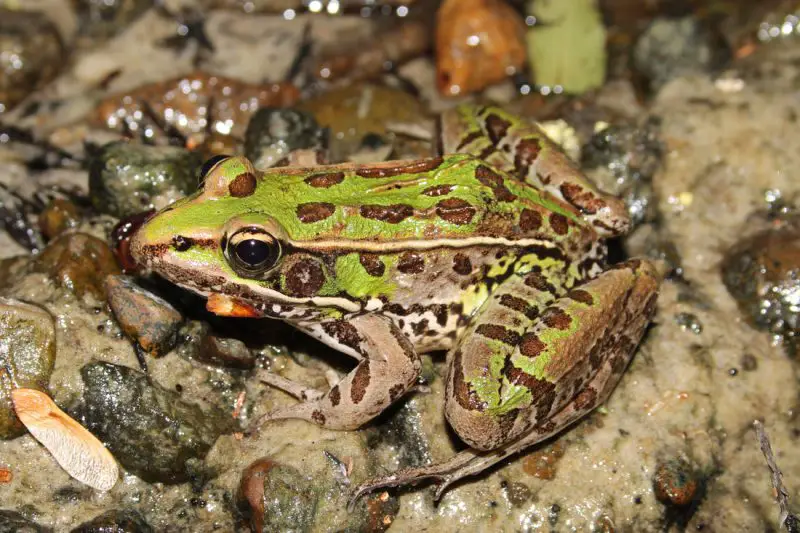
The Southern Leopard Frog is another spotted species native to Kansas, characterized by its smooth green or brown skin and distinct light stripe running along the upper jaw. It is medium-sized, reaching up to 3.5 inches in length, and is known for its agile leaps and energetic behavior. Its spots are usually smaller and less defined than those of its northern relatives.
This species inhabits ponds, marshes, and slow-moving streams, particularly in southeastern Kansas. Unlike some frogs, the Southern Leopard Frog is not strictly tied to water and can often be found wandering through moist grasslands or forest edges. During breeding season, which begins in early spring, males produce a distinctive chuckling call to attract females.
Southern Leopard Frogs feed on a variety of invertebrates including crickets, beetles, and flies. Their hunting activity increases at night when insects are most active. Tadpoles develop quickly in warm water, allowing the species to thrive even in temporary ponds that may dry up by midsummer.
In Kansas, this frog’s range overlaps slightly with that of the Plains Leopard Frog, but it tends to occupy more humid areas. Its adaptability and resilience make it one of the more successful amphibians in the state, maintaining steady populations despite environmental fluctuations.
Green Frog (Lithobates clamitans)
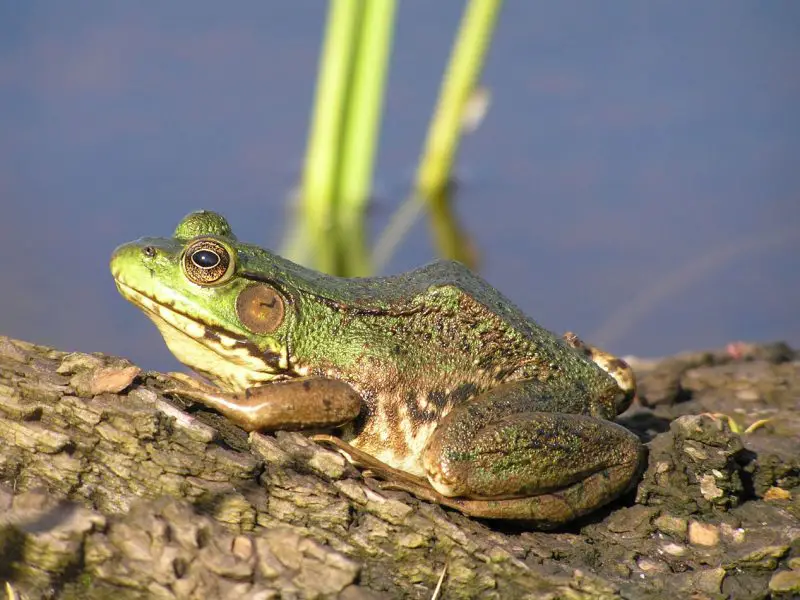
The Green Frog is a medium-sized species found across much of eastern Kansas. Its body ranges from bright green to bronze-brown with dark mottling and a prominent ridge running from the eye down each side of the back. Adults grow to about 3 inches long and have long, muscular hind legs for strong jumps and swimming bursts.
Green Frogs prefer habitats with permanent bodies of freshwater such as ponds, lakes, and slow-moving streams. They are less tolerant of dry conditions compared to other Kansas frogs. During the day, they are often seen basking near the water’s edge, ready to dive in at the slightest disturbance.
Their call is one of the most recognizable frog sounds in Kansas—resembling the plucking of a loose banjo string. Males call from floating vegetation or shallow water during the summer breeding season. Females lay eggs in clusters attached to submerged plants, and the tadpoles overwinter before transforming into juveniles the following year.
In Kansas, Green Frogs are common in the eastern and southeastern parts of the state, where humidity and vegetation provide ideal conditions. They play a crucial ecological role as both predator and prey, contributing to the balance of aquatic ecosystems by consuming insects and providing food for birds and snakes.
Pickerel Frog (Lithobates palustris)
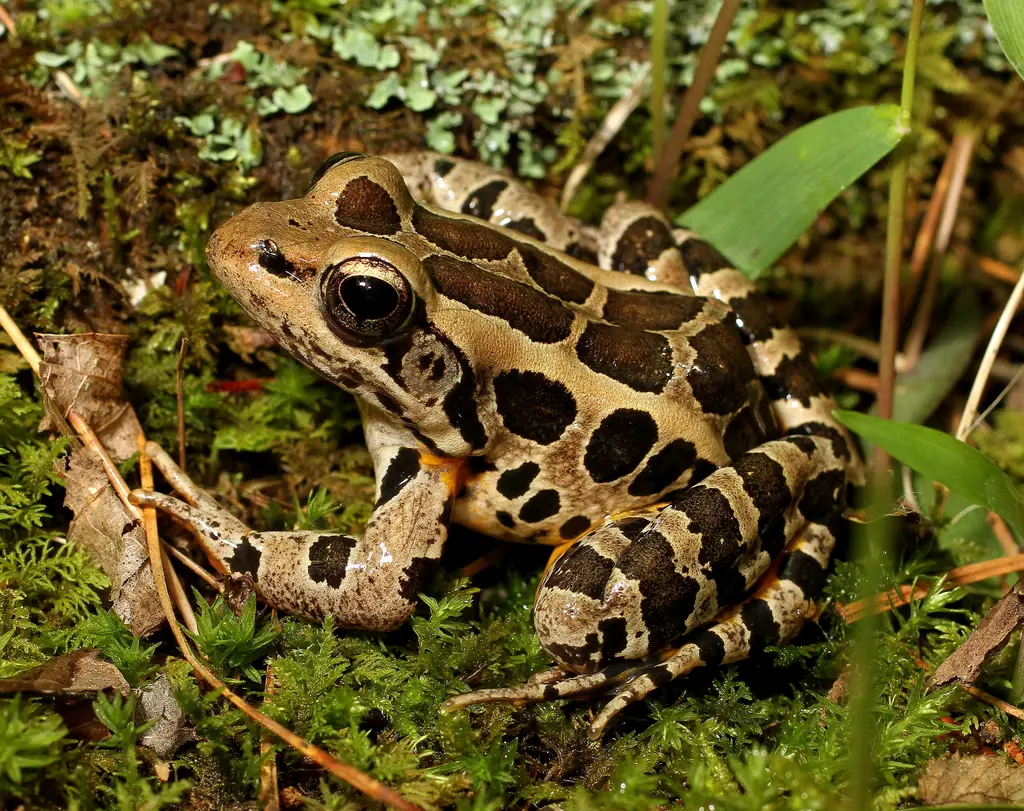
The Pickerel Frog is a beautifully patterned amphibian found in eastern Kansas, recognized by its two rows of square-shaped dark spots running down its tan or bronze back. Adults typically measure between 2 and 3 inches in length and have bright yellow or orange coloring on the inner thighs, visible when they jump. This striking color acts as a warning to predators, as the Pickerel Frog secretes mild toxins that can irritate the skin and mouths of would-be attackers.
These frogs inhabit cool, clean streams, spring-fed ponds, and moist meadows. They prefer unpolluted water and are often used as bioindicators of ecosystem health. During the breeding season in early spring, males produce a low, snore-like call, often heard at night or on overcast days. They lay large clusters of eggs in shallow water, which hatch into tadpoles within a few weeks.
Pickerel Frogs are carnivorous, feeding mainly on insects such as beetles, ants, and flies. They are diurnal, unlike many other frogs, meaning they are active during the day, especially in shaded, humid environments. Their excellent camouflage helps them blend into leaf litter and mossy areas to avoid predators.
In Kansas, the Pickerel Frog’s range is limited mostly to the eastern part of the state, where forested valleys and clear streams provide suitable habitat. Their dependence on pristine water makes them sensitive to pollution and habitat disturbance, so protecting clean waterways is vital for their long-term survival.
Crawfish Frog (Lithobates areolatus)
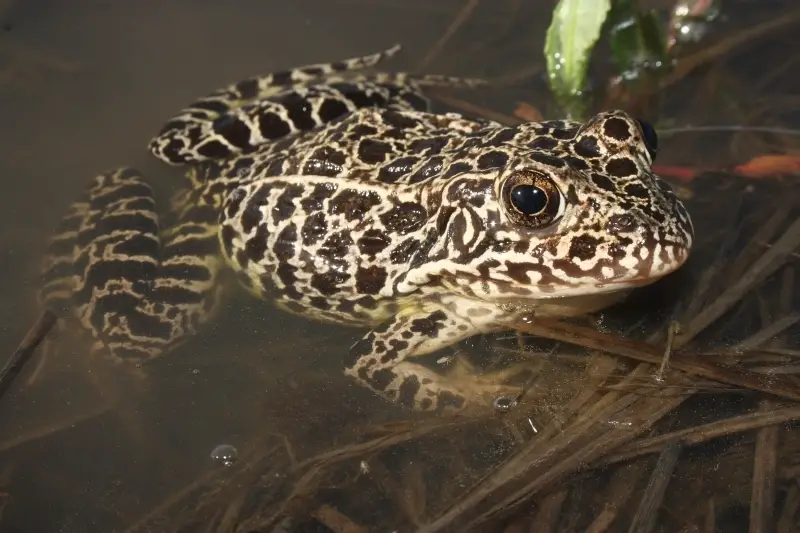
The Crawfish Frog is a unique and fascinating species found throughout the prairies and grasslands of Kansas. It is large and stocky, growing up to 4 inches long, with a light brown or yellowish body covered in dark, irregular rings. Its name comes from its habit of living in burrows made by crayfish, which it uses for shelter and protection during dry or cold periods.
This species spends most of the year underground and emerges only during the breeding season in early spring. Males gather near temporary ponds or flooded grasslands, calling with a deep, resonant snore that can carry long distances across open fields. After mating, females lay thousands of eggs in large floating clusters.
Crawfish Frogs primarily feed on insects, spiders, and small invertebrates that wander near their burrows. At night, they venture out to hunt but rarely stray far from their shelter. Their reliance on crayfish burrows makes them highly dependent on prairie ecosystems and soil conditions that support burrowing animals.
In Kansas, they are most common in the eastern and central regions where native grasslands persist. Habitat loss due to agriculture and urban development poses the greatest threat to this species. Conservation efforts focus on preserving natural prairies and wetlands to ensure the continued survival of this secretive amphibian.
Wood Frog (Lithobates sylvaticus)
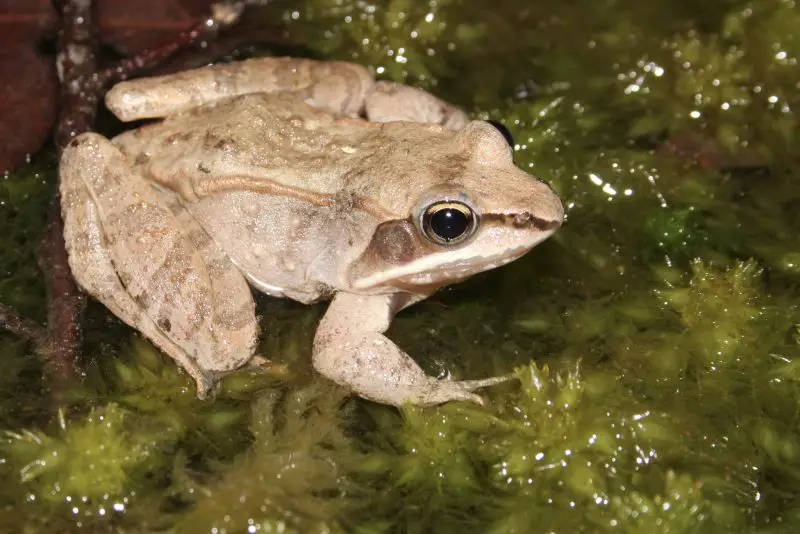
The Wood Frog is a cold-hardy amphibian best known for its remarkable ability to survive freezing temperatures. It has a tan to reddish-brown body with a distinctive dark mask-like marking across the eyes, resembling a bandit’s mask. Adults range from 1.5 to 3 inches long and have smooth skin with subtle dorsal ridges.
Wood Frogs are primarily found in the northernmost parts of Kansas, living in moist forests, wooded swamps, and shaded streams. They breed in vernal pools—temporary ponds formed by spring rains—where they lay clusters of eggs attached to submerged vegetation. Males produce a short, duck-like quacking call during the early spring breeding season.
Their diet consists mainly of small insects, worms, and spiders. Wood Frogs are active during the day, foraging on the forest floor where they rely on camouflage to avoid predators. During winter, they enter a state of suspended animation in which much of their body water freezes, yet they survive thanks to special sugars that protect their cells from damage.
In Kansas, Wood Frogs occur primarily in the northeastern regions where forest cover is suitable. They are considered rare in the state and are more common farther north. Their ability to withstand freezing makes them one of the most cold-tolerant amphibians in North America.
Cope’s Gray Treefrog (Hyla chrysoscelis)
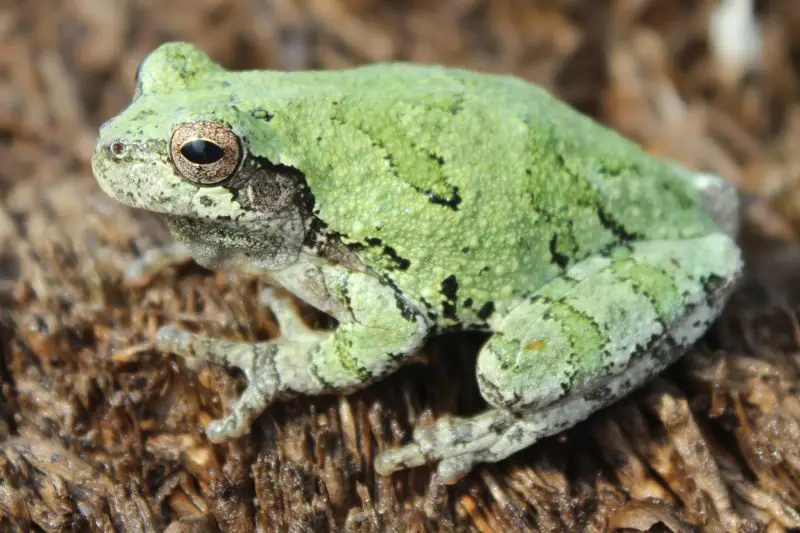
Cope’s Gray Treefrog is a small but charming species known for its exceptional camouflage and loud, musical trill. It varies in color from gray to green, often changing shades to match its surroundings. Adults typically grow to about 2 inches long and have rough, bumpy skin with bright orange or yellow patches on the inside of the thighs, visible during jumping.
This species prefers wooded habitats with nearby ponds, ditches, or wetlands for breeding. They are excellent climbers, using adhesive toe pads to grip bark, leaves, and even window screens. During the breeding season in late spring and summer, males call loudly from vegetation overhanging water, producing a rapid, high-pitched trill that can be heard from a great distance.
Cope’s Gray Treefrogs feed primarily on insects and spiders, which they hunt at night. Their ability to change color helps them blend into bark and foliage, offering protection from predators like snakes and birds. They are most active during warm, humid nights following rainfall.
In Kansas, Cope’s Gray Treefrogs are widespread, especially in the eastern and central regions. They often coexist with their close relative, the Gray Treefrog (Hyla versicolor), though the two species are nearly indistinguishable visually and differ mainly in their call frequency and genetic makeup.
Gray Treefrog (Hyla versicolor)
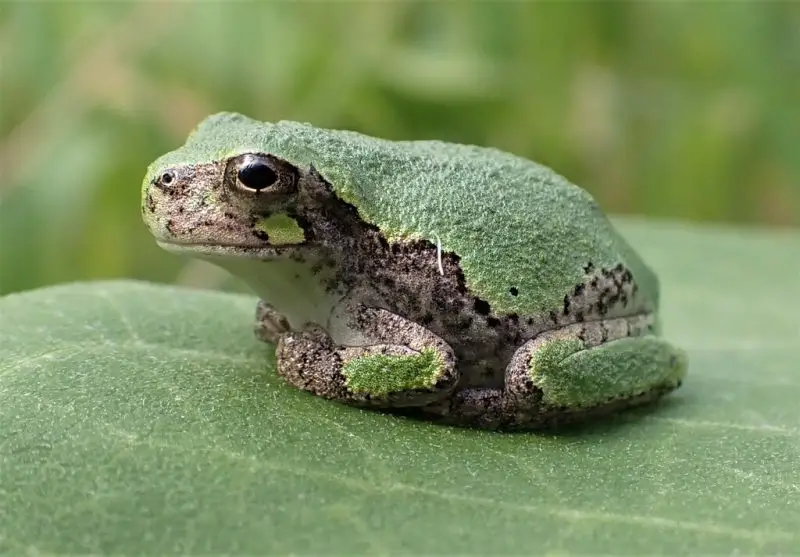
The Gray Treefrog is one of the most adaptable amphibians in Kansas, famous for its ability to change color from gray to green depending on temperature and environment. It is medium-sized, reaching about 2 inches in length, with rough skin and dark blotches across the back. Like Cope’s Gray Treefrog, it also displays vivid orange or yellow patches on its inner thighs.
Gray Treefrogs inhabit woodlands, suburban gardens, and areas near ponds or streams. They are arboreal, spending most of their lives in trees or shrubs and descending to water only during the breeding season. Males call from tree branches or the water’s edge, producing a slower, melodic trill compared to the rapid call of Cope’s Gray Treefrog.
Their diet consists of various insects, including moths, crickets, and beetles, which they capture with their long, sticky tongues. These frogs are nocturnal and rely on their excellent climbing ability and camouflage to avoid predators. They are also tolerant of moderate urbanization, frequently seen on windows or walls near outdoor lights.
In Kansas, Gray Treefrogs are found mostly in the eastern and southeastern regions. Their ability to survive in both rural and suburban environments makes them one of the most commonly encountered frogs in wooded areas. During winter, they hibernate beneath logs or leaf litter, where they can partially freeze and later thaw unharmed when temperatures rise.
Blanchard’s Cricket Frog (Acris blanchardi)
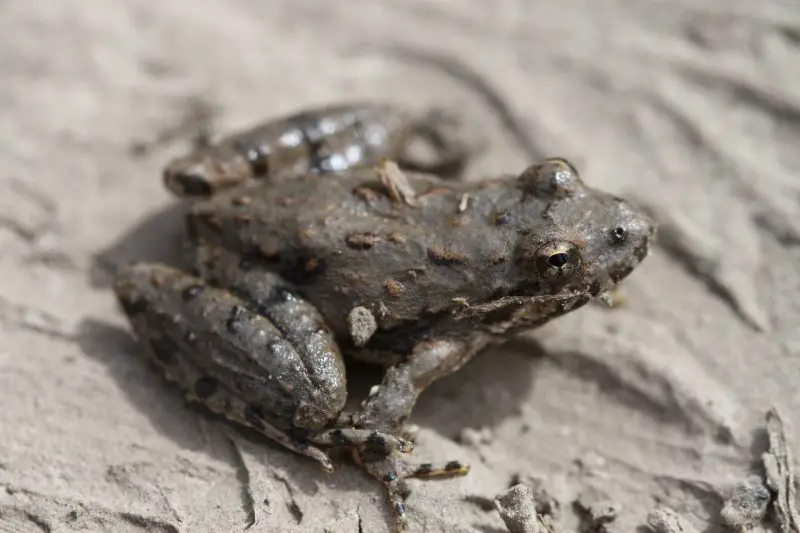
Blanchard’s Cricket Frog is one of the smallest frog species in Kansas, rarely exceeding 1.5 inches in length. Despite its size, it is highly energetic and easily recognized by its rough skin, triangular dark mark between the eyes, and varied coloration that can include shades of green, brown, or gray. This species often exhibits a distinctive light stripe down its back, which helps it blend into grassy or muddy surroundings.
These frogs prefer the shallow margins of ponds, lakes, and slow-moving streams, especially those with abundant vegetation. They are excellent jumpers, capable of leaping several times their body length to escape predators. Their call, resembling the rapid clicking of two small pebbles tapped together, can be heard from late spring through summer evenings.
Blanchard’s Cricket Frogs feed on small insects such as mosquitoes, ants, and beetles, which they actively hunt along the water’s edge. They are diurnal, often basking in the sun on muddy banks or floating vegetation. Despite their aquatic lifestyle, they can tolerate short periods of dryness, moving to damp soil or leaf litter during hot spells.
In Kansas, this frog is widely distributed across the state, from the eastern woodlands to western grasslands. Its adaptability to both natural and human-altered habitats has allowed it to remain common, although populations may decline in areas with heavy pesticide use or loss of wetland habitat.
Boreal Chorus Frog (Pseudacris maculata)
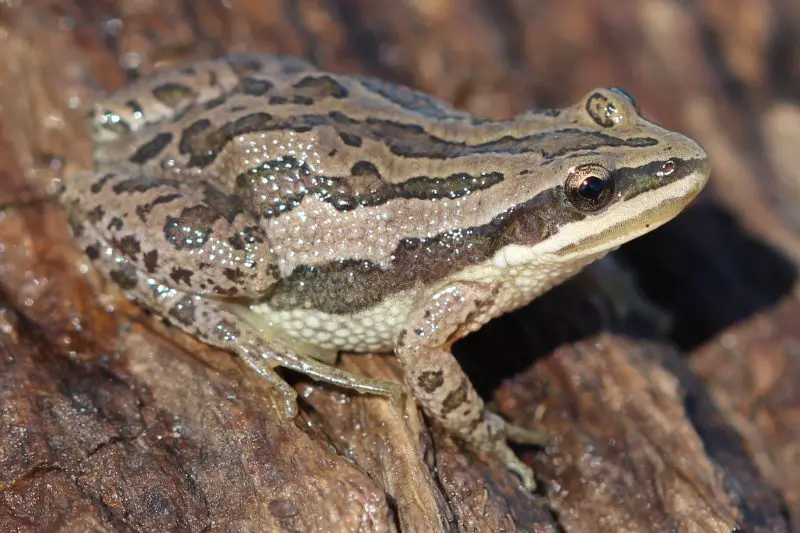
The Boreal Chorus Frog is a small, slender amphibian that rarely grows beyond 1.5 inches in length. It can be identified by three dark stripes running down its back and a broad stripe through the eye. Its coloration varies from gray to light brown or greenish, allowing it to blend with wetland vegetation. Despite its small size, it produces one of the loudest and most distinctive calls of any Kansas frog.
This species thrives in temporary ponds, flooded fields, and marshy grasslands, particularly during the early spring breeding season. Its call—resembling the sound of running a finger along a fine-toothed comb—is often one of the first frog songs heard after winter. Boreal Chorus Frogs are capable of surviving cold climates and are among the earliest amphibians to emerge each year.
They feed on small invertebrates, including gnats, flies, and mites. During dry periods, they seek refuge in moist soil or under leaf litter to prevent dehydration. These frogs are primarily nocturnal during the warmer months, becoming more active after dusk when humidity is higher.
In Kansas, Boreal Chorus Frogs are found mostly in the northern and central regions, preferring cooler, open habitats. Their tolerance of temporary water bodies allows them to thrive in agricultural landscapes, but habitat fragmentation and drought can reduce their breeding success in some areas.
Western Chorus Frog (Pseudacris triseriata)
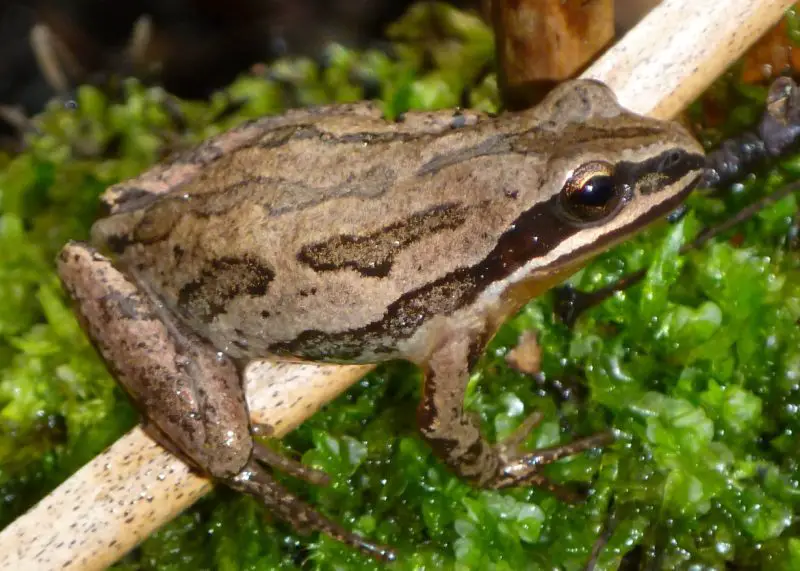
The Western Chorus Frog is a close relative of the Boreal Chorus Frog, and the two are often mistaken for one another. This small frog, reaching about 1.5 inches long, has three dark stripes along its back and a dark line extending through the eye to the shoulder. Its coloration ranges from gray to brown with lighter undersides, and its skin is smooth and moist.
It inhabits wetlands, ditches, flooded meadows, and woodland ponds across much of Kansas. Like its relatives, it breeds in early spring, often before many other frog species become active. Its call—a series of high-pitched, rising clicks—can be heard on rainy nights, signaling the start of the breeding season.
Western Chorus Frogs feed mainly on small insects, including flies, ants, and small beetles. They are agile and quick, able to hop short distances between vegetation while foraging. Outside the breeding season, they remain hidden under logs, rocks, or moist soil, emerging primarily during wet conditions.
In Kansas, they are widespread, particularly in the eastern and central parts of the state. Although common, their numbers fluctuate depending on rainfall and habitat quality. Conservation of temporary wetlands and floodplain areas is important for maintaining healthy populations of this early-calling frog.
Strecker’s Chorus Frog (Pseudacris streckeri)
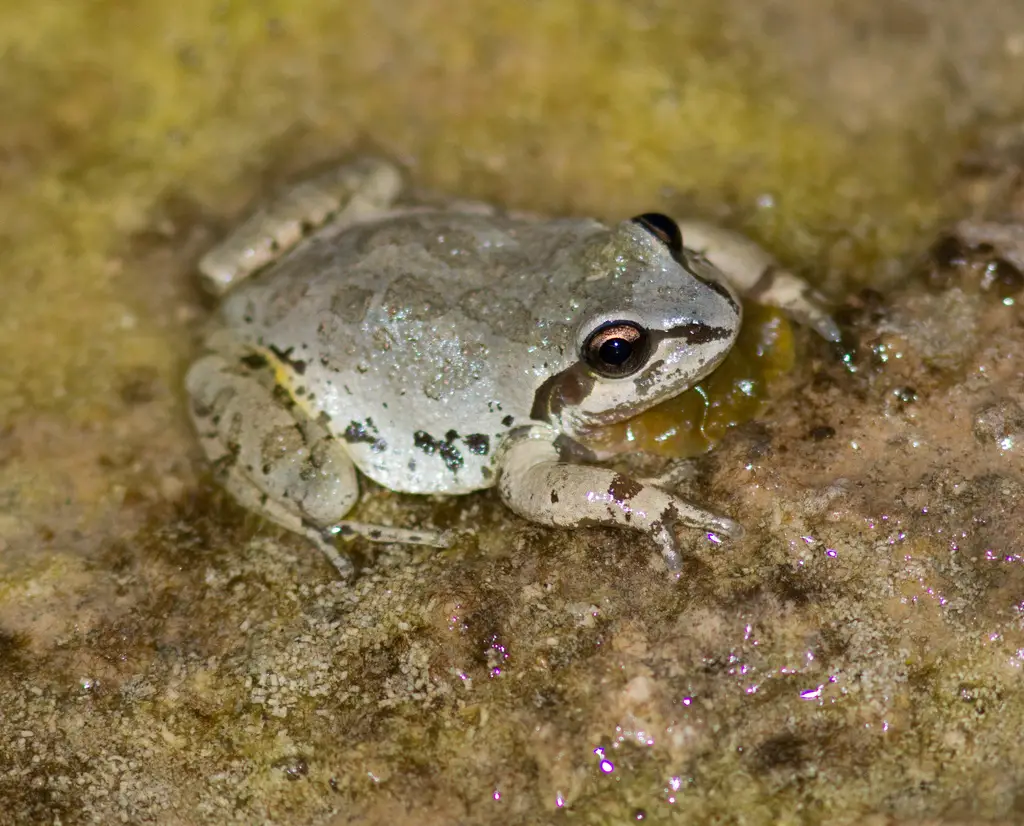
Strecker’s Chorus Frog is a small, chunky species that stands out for its bold, warty appearance and earthy coloration. Adults reach about 1.5 inches long and range in color from gray to brown, often with irregular dark blotches and a light stripe along the upper lip. This camouflage helps them blend perfectly with sandy or loamy soils typical of their habitat.
This species prefers dry, open areas such as prairies, pastures, and sandy fields near temporary ponds or ditches. Strecker’s Chorus Frogs are primarily nocturnal and spend much of their time buried underground, emerging only during rainy spring nights to breed. Their call is a loud, short trill that carries well across open landscapes.
They feed on small insects and other invertebrates, foraging on the ground near vegetation or moist soil. These frogs are well adapted to semi-arid conditions and can tolerate long dry spells by burrowing into the soil to retain moisture. During drought, they may remain inactive for weeks or even months.
In Kansas, Strecker’s Chorus Frogs are most common in the southern and central regions, particularly in areas with sandy soils. Their ability to survive in harsh, dry environments makes them an important part of the state’s prairie ecosystem, where few other frog species can persist.
Spring Peeper (Pseudacris crucifer)
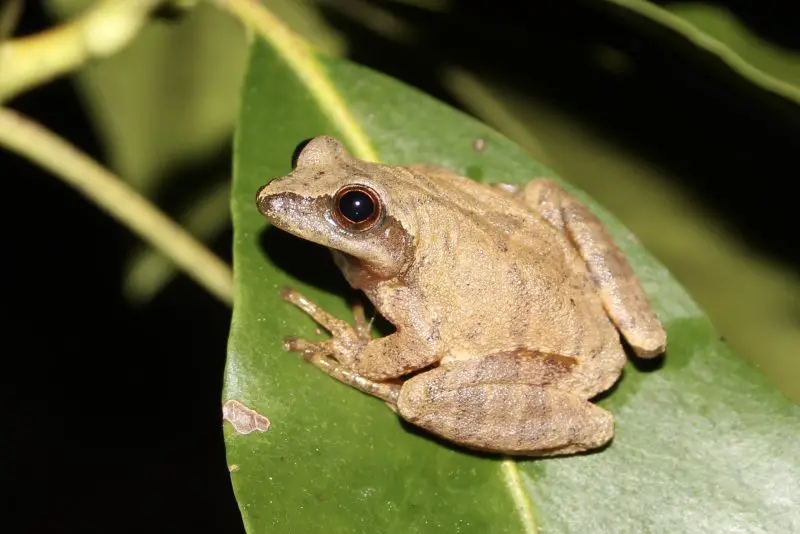
The Spring Peeper is a small but well-known frog famous for its loud, bell-like call that signals the arrival of spring. Adults measure about 1 inch long and have smooth tan, gray, or light brown skin with a distinct dark “X” marking on their back. Their rounded bodies and adhesive toe pads make them excellent climbers, though they spend most of their time near the ground.
These frogs prefer woodland ponds, marshes, and wet meadows, especially in the eastern parts of Kansas. Breeding begins as early as March when temperatures start to rise. Males gather in large choruses, producing shrill, repetitive “peep” calls that can be heard from great distances, sometimes forming one of the most familiar nighttime sounds of spring.
Spring Peepers feed on small insects, spiders, and other tiny invertebrates. They are nocturnal and most active during humid nights when insect prey is abundant. During the day, they hide under logs, bark, or leaf litter to stay moist and avoid predators.
In Kansas, they are found primarily in the eastern and southeastern regions, where forested wetlands provide ideal breeding conditions. Their early spring activity makes them among the first amphibians to appear each year, and their high-pitched chorus is a cherished sound marking the seasonal renewal of Kansas wetlands.
Tips for Observing Frogs in Kansas
1. Choose the Right Time
The best time to observe frogs in Kansas is during warm, humid evenings in spring and early summer. After rainfall, many frog species become more vocal and active, gathering near ponds, streams, and ditches to breed. Early morning or dusk are also great times for spotting them resting near the water’s edge.
2. Listen Before You Look
Each frog species in Kansas has a distinctive call, making sound one of the easiest ways to identify them. The deep “jug-o-rum” of the Bullfrog, the trilling notes of Chorus Frogs, or the sharp “peep” of Spring Peepers are key identifiers. Bringing a mobile app or audio guide that helps match calls can make your observations more rewarding.
3. Visit the Right Habitats
Frogs are found in diverse habitats across Kansas, from wooded ponds in the east to prairie wetlands and ditches in the west. Look for still or slow-moving water with nearby vegetation. During breeding season, temporary rain pools often host Chorus Frogs, while permanent ponds attract Bullfrogs and Leopard Frogs.
4. Use Gentle Observation Methods
When observing frogs, move slowly and quietly to avoid startling them. A small flashlight or headlamp with a red filter helps you see without scaring them away. Avoid handling frogs whenever possible — their skin is sensitive and can absorb harmful oils or chemicals from human hands.
5. Capture Photos Respectfully
For photography, use a zoom lens or macro setting to capture details without getting too close. Many frogs are shy and will dive into the water if they sense movement. Staying still for a few minutes allows frogs to resurface naturally, giving you a chance for perfect shots in their natural poses.
6. Support Frog Conservation
Kansas frogs face threats from pollution, habitat loss, and pesticide use. You can help by avoiding chemical treatments near ponds and gardens, maintaining natural vegetation along waterways, and supporting local wetland conservation programs. Every clean pond and natural space contributes to healthier frog populations.
7. Keep a Field Journal
Document your sightings with notes on the date, location, weather, and frog calls you hear. Over time, you’ll notice patterns in species activity and seasonal behavior. Recording these details can also help contribute to citizen science projects that monitor amphibian populations across Kansas.
FAQs About Frogs in Kansas
What time of year are frogs most active in Kansas?
Frogs in Kansas are most active from early spring through late summer, typically between March and September. As temperatures warm and spring rains arrive, species like the Spring Peeper and Boreal Chorus Frog begin calling near breeding ponds. Activity peaks in May and June, when males gather in loud choruses during the breeding season. By late fall, most frogs become inactive, burrowing underground or settling in pond bottoms to hibernate through the winter.
Where can I find frogs in Kansas?
Frogs inhabit nearly every part of Kansas, though the eastern regions have the greatest diversity due to their wetter climate. Look for them around ponds, lakes, marshes, creeks, and flooded ditches. Rural grasslands often host species like the Plains Leopard Frog and Crawfish Frog, while forested ponds attract treefrogs and Spring Peepers. Even suburban areas can support populations if there are small ponds or rain gardens with vegetation nearby.
How can I tell different frog species apart?
Kansas frogs vary in size, coloration, and especially their calls. For example, the American Bullfrog is large with a deep, booming “jug-o-rum” sound, while the Northern Leopard Frog has a spotted back and a chuckling call. Treefrogs such as Cope’s Gray Treefrog and the Gray Treefrog are smaller, have sticky toe pads, and produce rapid musical trills. Identifying frogs by sound is often the easiest way since many species are nocturnal and remain hidden.
Are there poisonous frogs in Kansas?
There are no deadly or dangerously poisonous frogs in Kansas. However, the Pickerel Frog does produce mild toxins from its skin that can irritate predators or people with sensitive skin. This secretion acts as a defense mechanism but is harmless when frogs are left undisturbed. Always wash your hands after handling any amphibian and avoid using insect repellent or lotion beforehand, as these can harm them.
What do frogs in Kansas eat?
Frogs in Kansas are carnivorous and play an important role in controlling insect populations. Their diet includes flies, mosquitoes, beetles, spiders, and crickets. Larger species like Bullfrogs also eat small fish, snakes, or even other frogs. Tadpoles, on the other hand, feed mostly on algae and decaying plant matter until they metamorphose into adult frogs. This diverse diet helps maintain a healthy ecological balance in Kansas wetlands.
How can I attract frogs to my garden or pond?
You can attract frogs by creating a small, clean water source such as a pond or water garden with shallow edges and native aquatic plants. Avoid using pesticides or fertilizers, as chemicals can kill frogs or disrupt their reproduction. Providing rocks, logs, or dense vegetation gives frogs places to hide and stay moist. If you live in eastern Kansas, species like Green Frogs and Gray Treefrogs are especially likely to visit backyard ponds.
Why are frogs important to Kansas ecosystems?
Frogs serve as both predator and prey in the food chain, making them key indicators of environmental health. They help control insect populations while providing food for birds, snakes, and fish. Because their skin absorbs moisture and oxygen, frogs are highly sensitive to pollution and habitat loss — meaning their presence signals a healthy, balanced ecosystem. Protecting frogs also protects the broader wetlands and water systems that support all wildlife.
What should I do if I find a frog during winter?
If you come across a frog during the cold months, it’s best to leave it where it is. Many frogs in Kansas hibernate underground or underwater in mud and leaf litter. Disturbing them can interfere with their survival. If a frog appears trapped indoors, gently release it near a pond or damp wooded area where it can find natural shelter.

